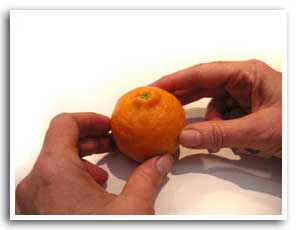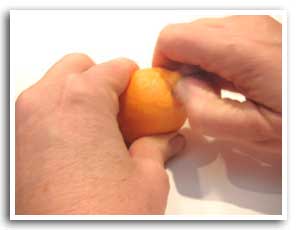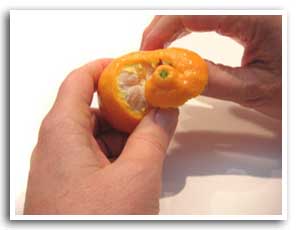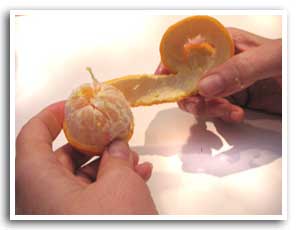
How to Peel a Pixie
When are Ojai Pixies in season?
Ojai Pixie harvest begins in March and continues into the early summer or until we run out.
Can I visit an Ojai Pixie farm?
Unfortunately no, due to insurance and food safety none of the Ojai growers can have public visitors. Friend’s Ranches does have their farm shop open on Tuesday and Friday mornings where they sell lots of citrus and more. The Sunday Ojai farmers’ market is also a great place to pick up Ojai Pixies and other local produce. Other nearby farms worth visiting are Ojai Olive Oil and Underwood Family Farms (Underwood is about an hour from Ojai and has loads of army things to do including u-pick).
Where can I purchase a tree?
The Ojai Pixie Growers group does not serve as a nursery; we do not sell trees.
Any good nursery should be able to order a Pixie Tangerine tree for you. Be sure to give the nursery advanced warning as it often takes several months to a year for them to get specialty varieties such as the Pixie! In temperate northern hemisphere climates it is best to plant citrus in the late spring or early summer. Remember, Pixies don’t grow well in all microclimates, they like the hot summers of Ojai and warm winter days (Ventura is too cool in the summer and Bakersfield is too cool in the winter for development of good flavor). The fruit is less frost tolerant than other varieties as they are small and not as juicy as early-season tangerines during Dec-Jan.
Beware the dreaded Asian Citrus Psyllid. You should be aware of this pest if you grow or plan to grow citrus.
Your county agricultural extension office or the USDA good sources for information about growing your own food in California. UC Cooperative Extension Service
How do I select a good Ojai Pixie?
Some Ojai Pixies are lumpy and bumpy, others have smooth skin, some are big and some are tiny but inside they are all sweet and juicy! In our experience, Pixie tangerines grown in some areas outside of Ojai may not be of the same quality, as Pixies are very sensitive to microclimates and Ojai has the perfect climate to grow perfect, sweet Pixie tangerines.
How nutritious are Pixie tangerines?
Pixies have a lower acid content than many other citrus varieties making them the ideal fruit for folks that are sensitive to acidic foods.
We have found that Ojai Pixies are one of the easiest ways for adults and kids to fulfill their consumption of 5 daily fruits and vegetables that the USDA recommends in order to stay healthy.
A medium sized tangerine is cholesterol- and fat-free and has on average approximately 50 calories. Tangerines are an excellent source of potassium (approx. 180mg), fiber (approx. 12 percent of the daily recommended allowance) and are of course packed with vitamin C as well as some calcium and iron.
Pixies do contain plenty of sugar in the form of fructose, so don’t eat the whole bag if you are sensitive to high sugar levels!

Step 1 – Pop the top
How long will Ojai Pixies last? Should they be refrigerated?
Ojai Pixies last at least several weeks from the time at which they are picked from the tree. They do not need to be refrigerated, but should be kept cool. Like all citrus fruit, Ojai Pixies should not be stored in plastic bags as plastic makes them sweat and increases the likelihood of spoiling.
How can I order Ojai Pixie Bumper Stickers?
If you are interested in ordering our Bumper Stickers please email us your mailing address. Bumper Stickers are free of charge; we promise to put some in the mail for you.
How can I order Ojai Pixie T-Shirts or other Ojai Pixie garb?
Please check the Friend’s Ranches website for information on ordering Ojai Pixie T Shirts, hats, lunchboxes and other Ojai Pixie goodies. When they are available the growers at this Ojai Pixie farm sell Ojai Pixie swag.
How are Ojai Pixies related to other varieties of tangerines/mandarins?
All tangerines are mandarins, but not all mandarins are tangerines. The name ‘tangerine’ originated from fruit grown in Tangiers and has been used in the United States for many varieties of mandarin. Ojai Pixie Growers have adopted it for the Pixie.
The Pixie tangerine was developed by Howard B. Frost at the University of California Citrus Research Center in 1927. James W. Cameron and Robert K. Soost later worked with the Pixie and the variety was released for commercial production in 1965 which is when the first trees were planted in the Ojai Valley.
There are several hundred varieties of mandarins in the world, of which several dozen are grown commercially in great quantities.
Historically in California we grew the Dancy, which is a lovely, loose-skinned, comparatively late season, and scrumptiously delicious tangerine. They don’t store well either on or off the tree, and they have seeds, which in recent years has made them commercially undesirable, but their flavor still defines “tangerine” for many of us.
For many years the Christmas tangerine has been the Satsuma, a loose-skinned seedless early maturing variety which originated in Japan.

Step 2 – Push your thumb under the skin at the top of the fruit, then rotate it as you gently spiral the skin off the Pixie
Spain has been exporting Clementines, which are a family of tangerine varieties, to the United States for the past few years; now some growers in California have planted enormous orchards (one man has planted 500,000 trees!) of some varieties of Clementines. You can find them in produce stores marketed as “Halos”, “Cuties” and “Sweeties.”
Traditional breeding of citrus has been going on since citrus has been propagated by humans. Taking pollen from one citrus tree and pollinating flowers of another citrus tree can give rise to a new fruit which can be propagated or crossed with other citrus. Over many hundreds of years this has led to the diversity of citrus fruits we have today.
The plant breeders at UC Riverside are still working to develop new varieties. As consumer tastes have changed, California orange growers have been switching to tangerines. This is probably good for the consumer, you now have the opportunity to sharpen your taste buds on a number of new citrus sensations. We hope you’ll remember the Ojai Pixie Tangerine as all these new varieties come into production.
Why don’t Ojai Pixies have seeds?
The Pixie Tangerine arose from open pollination of a Kincy (King mandarin crossed with Dancy Tangerine) in 1927. This pollination led to fruit that is naturally seedless and was named the Pixie Tangerine. As with seedless Navel oranges, buds have been taken from this tree and grafted onto rootstocks to create all the new Pixie Tangerine trees.
The fact that a fruit or vegetable has no seeds does not mean that it has been irradiated or genetically engineered. Pixie tangerines have been neither irradiated nor genetically engineered.
How do I grow a Pixie tree?
Like all citrus, Pixie tangerines require a frost-free environment in which to grow. Pixies grow best in areas with mild winters and hot summers. All citrus should be grown in areas of full sun. Pixie tangerine fruit stays on the tree during the winter months and is therefore quite susceptible to damage by cold weather.
Ojai Pixie growers have been growing Pixies since the 1960’s and in our experience this variety of tangerine is extremely sensitive to microclimates even within the small valley of Ojai. Another difficulty in growing Pixies is that they are quite alternate bearing, only producing a larger crop every other year. The other difficult thing is a new disease transmitted by the dreaded Asian Citrus Psyllid. You must be aware of this pest if you grow or plan to grow citrus.
Our advice to people interested in growing Pixies is to plant a tree, see how it grows and what the fruit tastes like before planting larger numbers of trees. Unlike many tangerine varieties the fruit ripens in late spring not during the winter holidays.

Step 3 – Make sure you get a few sections before your friends snatch it away (2-year olds do this…)
Can I order Ojai Pixie Tangerines by mail?
There are three ways to mail-order Ojai Pixie Tangerines:
- Directly from the farmer, at Friend’s Ranches: www.friendsranches.com, 805-646-2871
- Farm-direct certified organic Ojai Pixies from Churchill Orchard: www.tangerineman.com, 805-646-4212
- From Melissa’s World Variety, at www.melissas.com, 800-468-7111

